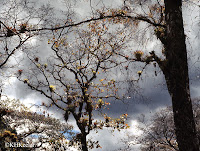 |
| pineapple plants |
The story of pineapples reminds us of a time when you couldn't zip around the globe in an airplane…
 |
| Lots of bromeliads in Costa Rican trees |
The pineapples we see in grocery stores are the fruit of herbaceous plants, scientifically Ananas comosus, in the bromeliad family, Bromeliaceae. The bromeliads are almost entirely confined to the New World. Most bromeliads are epiphytes, living on trees (see photo), but pineapples grow on the ground (photo above).
Pineapples were apparently domesticated prehistorically in South America and dispersed throughout all tropical America in very ancient times.

The native people of Guadalupe, and other Caribbean islands, considered sharing pineapples a symbol of hospitality. When Columbus landed on Guadalupe on his second voyage in 1493, they offered him pineapples.
Columbus and his men thought the pineapples were delicious. Columbus called them "pine of the Indies." The men in his crew and subsequent Spaniards called pineapples piña, from "pine" in Spanish. Apparently because it reminded all of them of a pine cone. The name piña or pine for pineapples carried over into English initially. In 1633, Gerard called it the pinia or pine thistle in his Herball. (It was not included in the first edition of the Herball in 1599, the one you can find online).
John Worledge is given credit for saying the fruit was "like a pineapple" in 1676. At that time, the word apple was used for any fruit, so a pine apple was the fruit of a pine tree, today called a pine cone. That name stuck, replacing pine of the Indies, pine thistle and older names. Despite the shared names, pineapples are obviously not much like either pines or apples.







